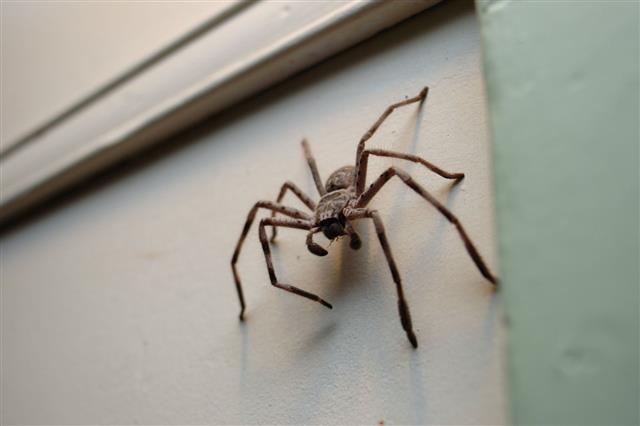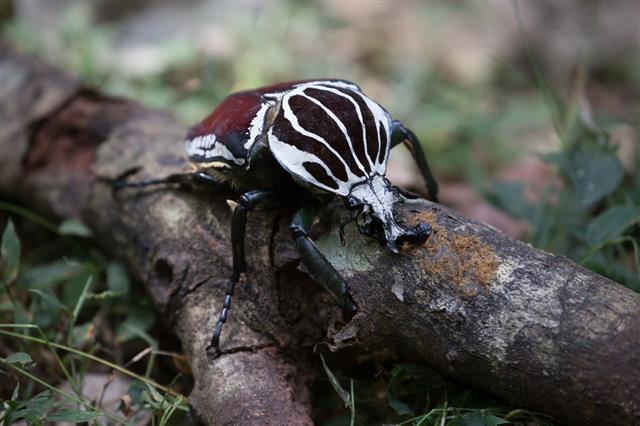
This title is shared by two spider species – the Goliath birdeater, which is the largest spider by body mass, and the giant huntsman, which is the largest spider by leg span.
The very mention of the word ‘spider’ may be enough to terrify some people. For them, spiders are gross and scary creatures with eight legs and a hairy body. What if they encounter a giant spider, like the Goliath birdeater? Though this spider is fairly harmless to humans in terms of venom, it is huge enough to terrify a person, who is normally not scared of spiders. However, there are people, who like spiders and in fact, the gigantic Goliath birdeaters are now very popular as pets.
There are various parameters that are taken into consideration, to determine the largest among the numerous spider species. They include the body weight and length (leg span). While the Goliath birdeater holds the distinction of being the heaviest spider in the world, the giant huntsman spider is the longest.
GOLIATH BIRDEATER (Largest by Body Mass)
How Big Are They?
The Guinness Record for the largest spider belongs to a female Goliath birdeater, which weighs around 175 grams. So, when it comes to body weight, the Goliath birdeater is the largest spider. In terms of leg-span, it is the second largest spider in the world (after the giant huntsman). It can have a leg span of up to 30 centimeters. The males of this species are longer, whereas the females have more girth than length.
Do They Look Scary?
If you are afraid of spiders, Goliath birdeaters may appear scary. They are giant spiders, with a hairy body. Another fearful feature is the long fangs with poison glands. The fangs can be one to two inches in length. You may also find these spiders producing hissing sounds, by rubbing their legs.
Are They Venomous?
Of course, Goliath birdeaters are venomous. Though the venom may prove fatal for smaller animals, humans may not develop any complication due to their bites. However, symptoms like pain, nausea, and swelling may occur. In most cases, these tarantulas bite humans in self-defense, and such bites may not involve use of venom (dry bites).
Where Do They Live?
Goliath birdeaters are found in the rainforests of South America. Their habitat includes the wet swamps and marshy areas. These spiders are usually found to occupy deserted burrows. They are burrowing in nature, and use their fangs for digging.
Do They Eat Birds?
Goliath birdeaters (Theraphosa blondi) are the heaviest spiders in the world. It is said that some Victorian explorers had seen one of these spiders eating a hummingbird, and hence, the name. In reality, these spiders are not regular birdeaters. However, they may occasionally feed on bird hatchlings. Usually, their diet includes insects, invertebrates, and small vertebrates. They feed on beetles, lizards, frogs, rodents, snakes, bats, etc.
Goliath Birdeaters as Pets
They are giant spiders that are said to be very aggressive. It is not advisable to keep spiders as pets, if you are not a person who is experienced in handling these arachnids. Goliath birdeaters are very large in size, they are aggressive and are too delicate to handle. However, the main reason against keeping them as pets, is their hair-flinging nature. If threatened, these spiders rub their hind legs on the abdomen and fling the bristled hair. If exposed to these hair, humans may develop irritation of the skin and the lungs. It may cause severe symptoms, especially when the hair comes in contact with the eyes and the mouth. They are so delicate that their body may split into pieces, if they suffer even a minor fall.
Know More About Goliath Birdeaters
- These spiders are solitary creatures with a body color that ranges between light to dark brown. Some of them have leg markings too. Goliath birdeaters molt (periodic shedding of the cuticle in arthropods) as they grow, and they have the ability to regrow lost limbs.
- The lifespan of these spiders varies with gender. While the females are found to live for around 15 to 25 years, in case of males, the lifespan is only three to six years. The females have an egg sac in their abdominal region. A single female can lay around 100 to 300 eggs, which may take almost two months to hatch. The females may kill the males, after mating. This could be one of the reasons for the short lifespan of male Goliath birdeaters.
- Though these spiders have eight eyes, their eyesight is very weak. However, they can sense vibrations with the sensory hair on the body, and detect movements around them.
- Usually, they do not climb trees due to their body weight. They overpower the prey with their huge body, and inject venom through the fangs. As they have no teeth to chew, these spiders adopt a different mechanism to ingest food. They inject venom into the body of the prey, so that the soft tissues can be broken down and easily ingested.
GIANT HUNTSMAN (Largest by Leg Span)
As the name rightly suggests, these spiders are well-known for their hunting skills. With the long, lean legs, they can move very fast, and chase down their prey. It is due to the length of its legs that the giant huntsman spider (Heteropoda maxima) is considered the longest among the different spider species. The leg span of a giant huntsman could be more than 35 centimeters (1.15 foot). This spider species was discovered in Laos, in 2001.
Giant Huntsman Facts
- They are usually found in lighter shades of yellowish brown, with band-like marks, and small hair on their legs.The rear end of their body may sport dark spots, which may not be uniform in all members. Their legs bend forward, as in crabs.
- It is speculated that huntsman spiders are cave dwellers. These nocturnal spiders can be found in the warm regions of Australia, South and Central America and Asia.
- Huntsman spiders pounce on their prey, instead of making webs for hunting purposes. They can hold still and wait, before chasing and pouncing on the prey. Once the prey is caught, the spider injects venom to liquify the soft tissues, which can be easily ingested. They are found to feed on insects and small invertebrates.
- Though their bites are not life-threatening, giant huntsman spiders can scare you with their gigantic size and crab-like movements. Their bites can cause discomfort and pain, but may not be harmful for healthy humans. In some people, headache, nausea, and fever may also develop. If they feel threatened, these spiders may make scary movements and sometimes cling to your body or clothes.
In short, both these spider species are gigantic in size. While one is the largest by body mass, the other wins the race with the longest leg span. However, there are many more spider species still to be discovered. So, there are chances of new contenders coming up in the future!





